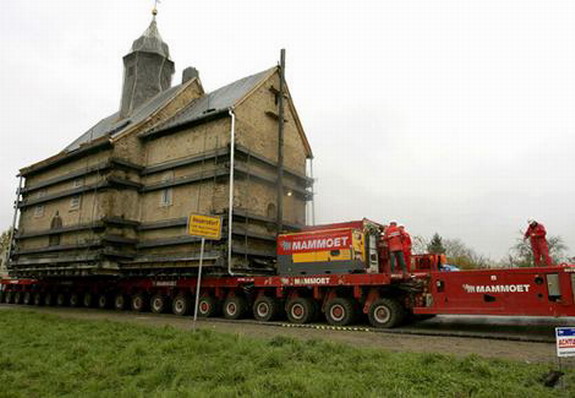Insane Engineering
Archive from 2007-2008 (many links in this page are no longer operational)
Amazing stories pushing the boundaries of what mankind can achieve.
Note, railway-related entries have moved here
|
Space Exploration Orbital Power station Space Elevators |
Pushing Boundaries Ship on Legs DARPA Urban Challenge The Helicopter problem Particle Accelerator Powerful stuff, water |
Geo The Flattest place on earth World largest swimming pool |
Big Machines The Bagger 288 The T282 Moving a 600 tonne church |
Powerful stuff this Water.
7 November 2008:Recently, on the 16mmngm e-group, a supplier mentioned that he was working on some parts for a model locomotive kit (live steam, of course). He said that the side frames would be machined using Water-jet cutting.
The same day, by coincidence, a friend sent me a link about another use for a water-jet cutter. Water-jet cutting is an established method of cutting materials, including steel, using a very high pressure jet of (you guessed it) water. The link from my friend shows some machinists having fun with an X-box.

Montage: © Andy Watkins
Originals © waterjets.org.
The whole article is at www.waterjets.org/waterjet_pictures_9.html
You can find out more about these cutters at en.wikipedia.org/wiki/Water_jet_cutter.
CERN's Particle Accelerator
10 September 2008:A page about insane Engineering achievements wouldn't be complete without something about the enormous scientific experiment below the Franco-Swiss alps, which was started today.
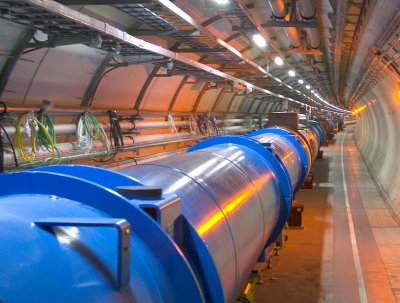
Credit: John Adams Institute for Accelerator Science
I don't need to re-iterate what others have explained well. Head over to the the BBC or CERN to find out more about the world's largest Refrigerator-Super-Vacuum-Physics-Experiment-Doughnut.
Personally, I like the fact that they had to freeze the ground using liquid nitrogen, just to build the underground caverns through glacial deposits!
The Helicopter Problem
June 2008:A helicopters' forward speed is limited by two main factors:
Firstly, as the rotor blades on one side move backwards with respect to the forward motion of the helicopter, a point can be reached where the blade is briefly stationary in the air, which causes it to stop generating lift. This is bad news for keeping the helicopter in the air!
Secondly, on the other side of the fuselage the blade tip which is going forward will start going supersonic well before the actual helicopter does, creating enormous stresses on the blades. If you increase the rotor speed to prevent the retreating blade tip from stalling, the forward running blade tip will reach the sound barrier sooner.

Black Hawk. Credit unknown.
The exercise for the Aero Engineering student is to make a helicopter which can travel faster without (a) losing lift on one side of the fuselage, and (b) exceeding mechanically destrictive Mach 1 on the other!
Thanks to the Register for these fascinating facts.
Footnote: Most helicopter rotors spin at a fixed speed. Getting them to spin at variable speeds is, apparently, very difficult. Our imaginary Aero Engineering student can take on this challenge for bonus points and aim to beat the endurance record
Even bigger mining machinery
April 2008:Just when I thought the The T282 was big, along comes an email (thanks to Justin) about something even bigger! Here is the Krupp Bagger 288, an earth-mover, custom-made for a German lignite mine. The machine weighs 13,500 tons and can dig out 240,000m³ of material in a day. It's the largest vehicle on Earth.
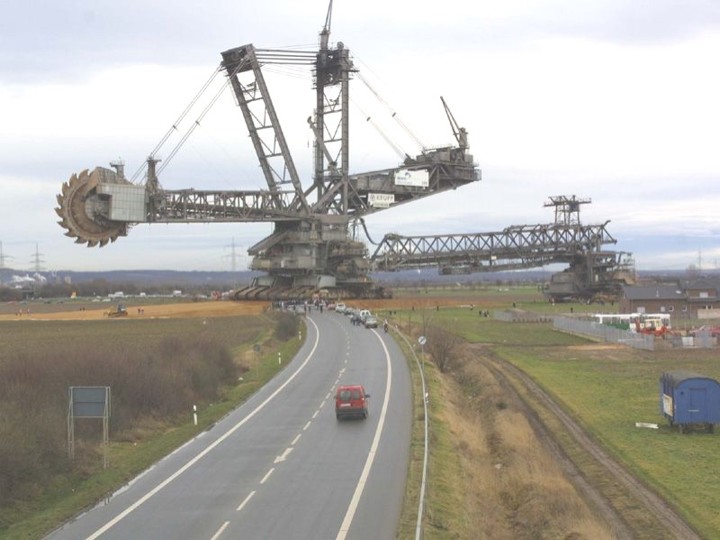
Credit unknown.
The earthmover is shown here crossing an Autobahn, following completion of its first contract. It was cheaper to drive the excavator the 22km to its new mine, including crossing a road, a railway and a river, than to take it apart and reassemble it. There are more details of the move here.
Click on the photos for more views. The fourth photo, above shows it on Google Maps. You can clearly see the arc swept by the cutting arm, and to the north, the conveyor belt which takes the coal to a nearby power station. Click here to see if it's still in the same spot.
There are plenty more photos here and here and some videos here and here
The Bagger 288 requires an external 16.5 megawatt electrical supply, and is used for strip-mining a kind of coal called Lignite. It's not particularly environmentally friendly.
The largest dump truck in the world
March 2008
The Liebherr T282 is the world's largest dump truck. This vehicle is so large, that to reach the cab, you can climb the staircase in front of the radiator and walk along the balcony (in front of the electrical cabinets)
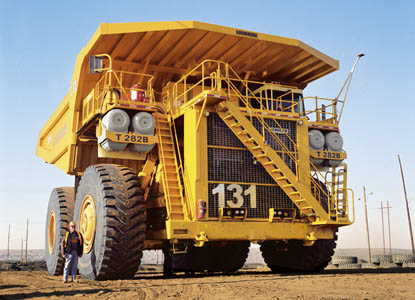
Payload: 260 tonnes
Max Speed 64 kmh (40 mph)
photo © Liebherr.
The World's largest swimming pool
March 2008
Somewhere in South America, they've built a gigantic swimming pool, about a kilometre long!
A Ship on legs
March 2008
Here's a crazy idea: build a ship with legs, so it can stand on the sea bed. I came up with this idea a long time ago, as a crane: it would float to the lift site, put its legs down and then operate just like a land-based crane, with its toes in the water, as it were.
Well, someone has gone and built one, for the purposes of installing wind turbines out at sea.
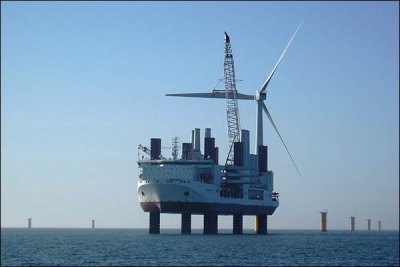
Image from
the BBC.
This ship, the MV Resolution, is according to the blurb, the 'world's first purpose-built vessel for installing offshore wind farms. It uses its six massive legs, each half the length of a football pitch, to hoist itself out of the water at a rate of a metre per minute to create a stable platform.'
Orbital Power Station
10 December 2007: The BBC are reporting that scientists across the world are trying to work out if an orbiting power station is reasible. The challenges include getting enough solar arrays up there, getting the power safely back down to the surface, and working out where the funding is going to come from...
Related to this are research projects into electrically powered space propulsion systems.
In Other news on the same day, Virgin Galactic are proposing using their launcher aircraft to sling satellites into low earth orbit, as well as using them for their original purposes of getting tourists into space.
The Flattest place on earth
October 2007
...is good for calibrating satellites.
3 December 2007:
It's reported that a salt flats
in Bolivia are so large, and so flat, that they're being used to calibrate
satellites which measure altitute. The salt flats are calm and don't have waves.
making them much more suitable for calibration than the ocean.
Salar de Uyuni is the flattest place on earth, apparently. It's about half the size of Wales.
Robot Cars
October 2007:3rd November: The DARPA Challenge this year was to build a robot car which can drive itself around a simulated urban environment. One contestant had a software malfunction which caused their truck to drive into a building. No-one was hurt.
A blog of the competition is available at The Register
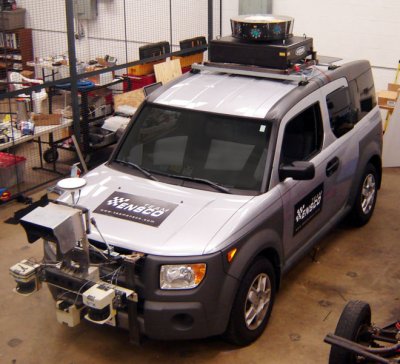
Public domain image from
Wikipedia.
Moving Church. 660 tonnes of it.
October 2007A church building in Eastern Germany was physically relocated to make way for mining. It's a 700 year old, 660 tonne building. They put it on wheels, and drove it down the road in one piece!
The following websites give more information
Photo Gallery from der Spiegel
Video report from ITN
More stories (Google)
Space Elevators.
Last updated: March 2008Back in 2004, the BBC reported progress on Carbon Nanotubes, the chemistry behind the new materials needed to build a lift from the equator into space.
By October 2007, materials based on Carbon Nanotubes started to appear in new body armour. Don't you think this guy looks like stormtrooper?
More space elevator news can be found here. There's an annual competition, the Space Elevator Games and major lines of research include climbers, transmitting power and thread construction (this is where the nanotubes come in).
The 2008 Space Elevator Games are planned to include a 1km lift. Even the mechanism for supporting a 1km ribbon (from a balloon) is a first.




